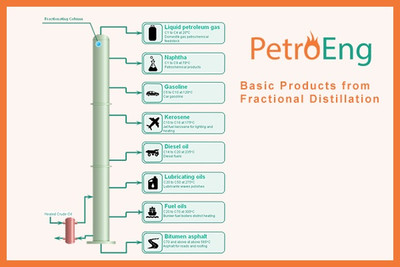8:43 AM Basic Products from Fractional Distillation |
 The basic refinery uses fractional distillation. Incoming crude is heated to its boiling point. It then enters the distillation column, which separates the different fractions. The column is of the reflux type, where colder condensed fluids running down are reheated by rising vapors that in turn condense. This produces clear thermal zones where the different products can be drained. The fractions are a mix of alkanes and aromatics and other hydrocarbons, so there is not a linear and uniformly rising relationship between carbon number and boiling point and density, although there is a rough fit. Even so, this means that each fraction contains a distribution of carbon numbers and hydrocarbons. The basic products from fractional distillation are: Liquid petroleum gas (LPG) has carbon numbers of 1-5 and a boiling point up to 20 °C. Most of the LPGs are propane and butane, with carbon number 3 and 4 and boiling points -42 °C and -1 °C, respectively. Typical usage is domestic and camping gas, LPG vehicles and petrochemical feedstock. Naphtha, or full range naphtha, is the fraction with boiling points between 30 °C and 200 °C and molecules generally having carbon numbers 5 to 12. The fraction is typically 15–30% of crude oil by weight. It is used mainly as a feedstock for other processes:
Gasoline has carbon numbers mainly between 4 and 12 and boiling points up to 120 °C. Its main use is as fuel for internal combustion engines. Early on, this fraction could be sold directly as gasoline for cars, but today’s engines require more precisely formulated fuel, so less than 20% of gasoline at the pump is the raw gasoline fraction. Additional sources are needed to meet the demand, and additives are required to control such parameters as octane rating and volatility. Also, other sources such as bioethanol may be added, up to about 5%. Kerosene has main carbon numbers 10 to 16 (range 6 to 16) boiling between 150 °C and 275 °C. Its main use is as aviation fuel, where the best known blend is Jet A-1. Kerosene is also used for lighting (paraffin lamps) and heating. Diesel oil, or petrodiesel, is used for diesel engines in cars, trucks, ships, trains and utility machinery. It has a carbon number range of 8 to 21 (mainly 16-20) and is the fraction that boils between 200 °C and 350 °C. White and black oils: The above products are often called white oils, and the fractions are generally available from the atmospheric distillation column. The remaining fraction below are the black oils, which must be further separated by vacuum distillation due to the temperature restriction of heating raw crude to no more than 370-380 °C. This allows the lighter fractions to boil off at a lower temperatures than with atmospheric distillation, avoiding overheating. Lubricating oils, or mineral base lubricating oil (as opposed to synthetic lubricants), form the basis for lubricating waxes and polishes. These typically contain 90% raw material with carbon numbers from 20 to 50 and a fraction boiling at 300-600 °C. 10% additives are used to control lubricant properties, such as viscosity. Fuel oils is a common term encompassing a wide range of fuels that also includes forms of kerosene and diesel, as well as the heavy fuel oil and bunker that is produced at the low end of the column before bitumen and coke residues. Fuel oil is graded on a scale of 1 to 6 where grade 1 and 2 is similar to kerosene and diesel, 3 is rarely used anymore. 4-6 are the heavy fuels, also called Bunker A, B and C, where B and C are very high viscosity at normal ambient temperatures and requires preheating to about 100 °C and 120 °C respectively, before it flows enough to be used in an engine or burner. Fuel oil grade 4 does not require preheating and is sometimes mixed with off spec products, such as tank residue and interface liquid from multiphase pipelines or with grade 2 fuel oil to achieve low-enough viscosity at ambient temperatures. Fuel oil 6 is the lowest grade, its specification also allows 2% water and 0.5% mineral soil and is consumed almost exclusively by large ships in international waters, where pollutants such as sulfur is less regulated. Bitumen and other residues like coke and tar has carbon numbers above 70 and boiling points above 525 °C. Low sulfur coke can be used for anodes in the metals industry (aluminum and steel) after processing (calcining). The remainder is a problem fuel, because of high sulfur content and even higher CO2 emissions than coal (typically 15% higher). Bitumen in the form of asphalt boiling above 525 °C is used for roofing and road paving. Asphalt concrete pavement material is commonly composed of 5% asphalt/bitumen and 95% stone, sand, and gravel (aggregates).
|
|
|
| Total comments: 0 | |
